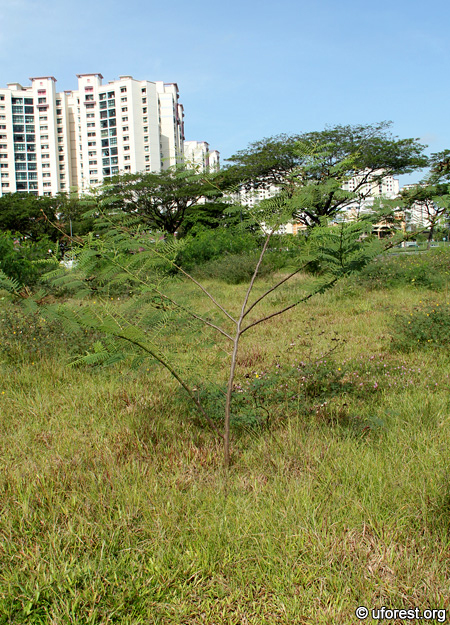| Etymology | Genus | Mimic; referring to the fact that the leaf respond to stimuli |
|---|---|---|
| Species | Slow or lazy; referring to the lethargic movement of the leaves' response to stimuli | |
| Family | Fabaceae | |
| Synonyms | - | |
| Common Names | Catclaw, Catclaw Mimosa, Giant Sensitive Tree | |
| Status | Exotic: Naturalised | |
| Form | Tree | |
| Native Distribution | Tropical America | |
Diagnostics:
This is a short tree found only in the open scrubland, where it shares the habitat with a shurb of similar height, Leucaena leucocephala. The pink flower clusters, sensitive leaflets which close upon touch, and prickles along the bipinnate leaves makes it easily identifiable.
Interesting Facts:
Mimosa pigra bears the infamous title of being listed as one of the 100 most invasive species in the world, together with Leucaena leucocephala (Lowe et al., 2004). It is able to establish in both wet and dry lands to form "thorny, impenetrable thickets over large areas" after disturbance (Weber, 2003). However, it only appears to be sparingly commonly in Singapore and does not occur at high densities.
The fruit pods when dried, fragment off in segments, leaving a persistent empty frame. Each segment contains a seed and is buoyant on water (Cronk & Fuller, 2001).

Leaves are bipinnate and bears many fine leaflets per pinna.

The Catclaw in a scrubland in Sengkang.

Two kinds of prickles arranged at right angles to each other.

Flower clusters are pink/mauve in colour.

Fruit pods are hairy.

Pod fragments transversely, leaving a persistent frame.
References
Cronk QCB & JL Fuller. (2001) Plant Invaders: the Threat to Natural Ecosystems. Earthscan Publications, London. 241 pp.Lowe S, Browne M, Boudjelas S & M De Poorter. (2004) 100 of the World's Worst Invasive Alien Species A selection from the Global Invasive Species Database. The Invasive Species Specialist Group, World Conservation Union. 12pp.
Weber E. (2003) Invasive plants of the World. CABI Publishing, CAB International, Wallingford, UK. 548 pp.
Author: Siyang
Posted: 2013-01-01 / Modified: 2019-08-27